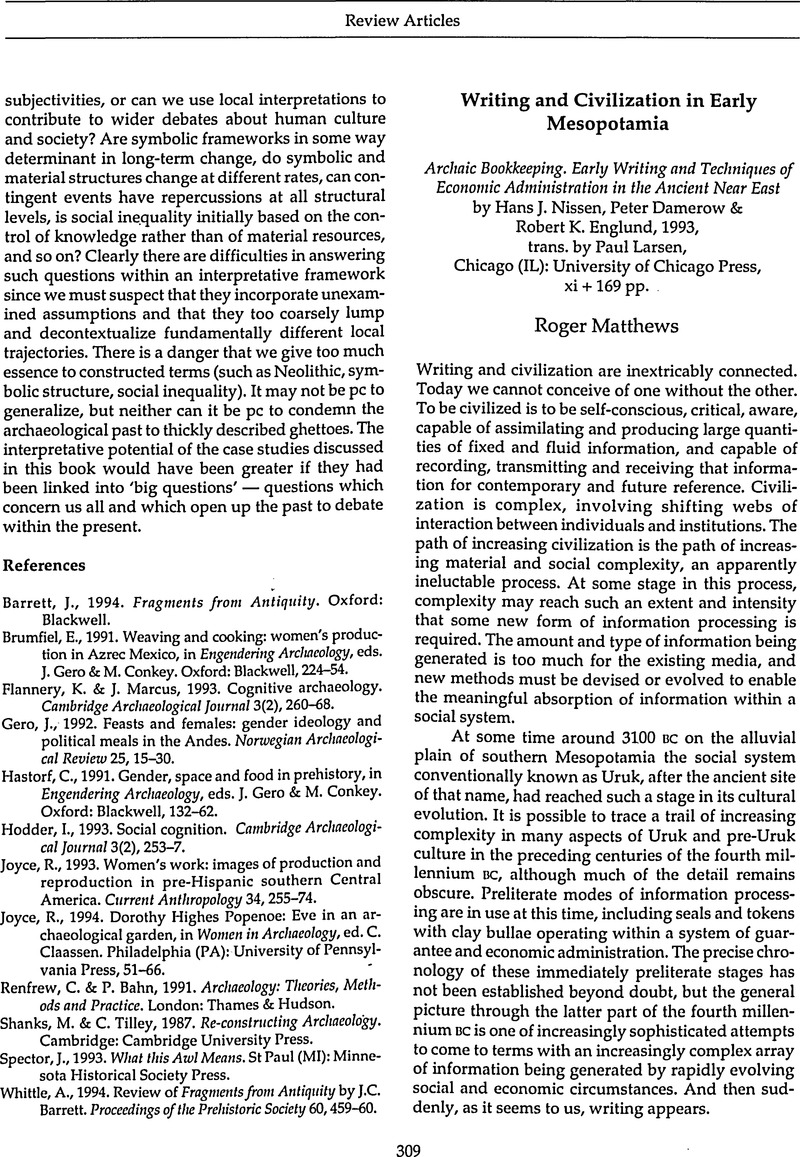No CrossRef data available.
Article contents
Writing and Civilization in Early Mesopotamia
Published online by Cambridge University Press: 14 October 2009
Abstract
An abstract is not available for this content so a preview has been provided. Please use the Get access link above for information on how to access this content.

- Type
- Review Articles
- Information
- Copyright
- Copyright © The McDonald Institute for Archaeological Research 1995
References
Algaze, G., 1993. The Uriik World System. The Dynamics of Expansion of Early Mesopotamian Civilization. Chicago (IL): University of Chicago Press.Google Scholar
Boese, J., 1986–1987. Excavations at Tell Sheikh Hassan. Les Annales Archéologiques Arabes Syriennes 36–37, 67–101.Google Scholar
Brandes, M.A., 1979. Siegelabrollungen aus den Archaischen Bauschichten in Uruk-Warka. (Freiburger Altorientalische Studien 3.) Wiesbaden: Franz Steiner.Google Scholar
Dittmann, R., 1986. Seals, sealings and tablets: thoughts on the changing pattern of administrative control from the Late Uruk to the Proto-Elamite period at Susa, in Ğamdat Nasr: Period or Regional Style?, eds. Finkbeiner, U. & Röllig, W.. (Beihefte zum Tübinger Atlas des Vorderen Orients, Reihe B 62.) Wiesbaden: Ludwig Reichert, 332–66.Google Scholar
Englund, R.K. & Grégoire, J.-P., 1991. The Proto-Cuneiform Texts from Jemdet Nasr I: Copies, Transliterations and Glossary. (Materialien zu den frühen Schriftzeugnissen des Vorderen Orients 1.) Berlin: Gebr. Mann.Google Scholar
Le Brun, A. & Vallar, F., 1978. L'origine de l'écriture à Suse. Cahiers de la Délégation Archéologique Française en Iran 8, 11–59.Google Scholar
Matthews, R.J., 1992. Defining the style of the period: Jemdet Nasr 1926–28. Iraq 54, 1–34.Google Scholar
Matthews, R.J., 1993. Cities, Seals and Writing: Archaic Seal Impressions from Jemdet Nasr and Ur. (Materialien zu den frühen Schriftzeugnissen des Vorderen Orients 2.) Berlin: Gebr. Mann.Google Scholar
Matthews, R.J., forthcoming. Offerings to the gods: seal impressions on archaic tablets, in Festschrift R.M. Boehmer.Google Scholar
Matthews, R.J., Matthews, W. & McDonald, H., 1994. Excavations at Tell Brak, 1994. Iraq 56, 177–94.CrossRefGoogle Scholar
Michalowski, P., 1990. Early Mesopotamian communicative systems: art, literature, and writing, in Investigating Artistic Environments in the Ancient Near East, ed. Gunter, A.C.. Washington (DC): Smithsonian Institution, 53–69.Google Scholar
Michalowski, P., 1993. On the early toponymy of Sumer: a contribution to the study of early Mesopotamian writing, in Kinattutu ša dàrâli. Raphael Kutscher Memorial Volume, ed. Rainey, A.F.. (Tel Aviv Occasional Publications 1.) Tel Aviv: Tel Aviv University, 119–33.Google Scholar
Moorey, P.R.S., 1994. Ancient Mesopotamian Materials and Industries. The Archaeological Evidence. Oxford: Clarendon Press.Google Scholar
Nissen, H.J., 1988. The Early History of the Ancient Near East, 9000–2000 BC. Chicago (IL): University of Chicago Press.CrossRefGoogle Scholar
Nissen, H.J., Damerow, P. & Englund, R.K., 1990. Frühe Schrift und Techniken der Wirtschaftsverwaltung im alten Vorderen Orient. Berlin: Verlag Franzbecker.Google Scholar
Pittman, H., 1994. The Glazed Steatite Glyptic Style. (Berliner Beiträge zum Vorderen Orient 16.) Berlin: Dietrich Reimer Verlag.Google Scholar
Wright, H.T., Miller, N. & Redding, R., 1980. Time and process in an Uruk rural centre, in L'Archéologie de l'Iraq: Perspectives et Limites de l'Interprétation Anthropologique des Documents. (Colloques Internationaux du C.N.R.S. 580.) Paris: Éditions du Centre National de la Recherche Scientifique, 265–84.Google Scholar


